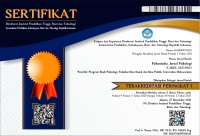Fostering Children's Independence: Behavioral Modification Strategies for Diaper Dependency
Abstract
Anak yang terbiasa menggunakan pampers sering mengalami kesulitan dalam melepas kebiasaan tersebut sehingga diperlukan strategi intervensi yang efektif untuk meningkatkan kemandirian dalam menggunakan toilet. Penelitian ini bertujuan untuk mengevaluasi efektivitas metode modeling dalam meningkatkan keterampilan toilet training pada anak melalui intervensi berbasis video dan reinforcement positif. Metode penelitian yang digunakan adalah eksperimen dengan desain Single-Subject Experimental Design (SSED) menggunakan A-B-A-B reversal design untuk mengamati perubahan perilaku sebelum dan sesudah intervensi. Hasil penelitian menunjukkan bahwa klien mampu memahami instruksi dan meniru perilaku toilet training dari video yang diberikan serta mengalami peningkatan dalam frekuensi dan durasi tidak menggunakan pampers di rumah. Namun, klien masih mengalami kesulitan dalam buang air besar di kloset dan tetap menggunakan pampers dalam situasi tertentu seperti saat berada di sekolah atau tidur. Implikasi dari penelitian ini menunjukkan bahwa metode modeling dapat menjadi strategi efektif dalam membentuk kebiasaan toilet training dengan dukungan lingkungan yang konsisten serta reinforcement yang tepat sehingga dapat diterapkan secara lebih luas dalam konteks pendidikan dan pengasuhan anak.
Keywords
Full Text:
FULL TEXTReferences
akker, E., van Gool, J., van Sprundel, M., van der Auwera, J., & Wyndaele, J. (2002). Results of a questionnaire evaluating the effects of different methods of toilet training on achieving bladder control. BJU International, 90(4), 456–461.
Choby, B., & George, S. (2008). Toilet training. American Family Physician, 78(9), 1059–1064.
Collins, P., & Coplan, R. (2005). The social adjustment of preschool-aged children: The role of self-regulation and behavioral inhibition. Early Childhood Research Quarterly, 20(1), 23–39.
Desmita. (2010). Psikologi perkembangan anak. Jurnal Psikologi, 37(1), 45–52.
Festiawan, R., Raharja, A., Jusuf, J., & Mahardika, N. (2020). Effect of Oregon Circuit Training and Fartlek Training on the VO2Max Level of Soedirman Expedition VII Athletes (Goes to Aconcagua Mountain: Argentina). Jurnal Pendidikan Jasmani Dan Olahraga, 5(1), 62–69.
Foxx, R., & Azrin, N. (2013). Dry pants: A rapid method of toilet training children. Behaviour Research and Therapy, 183(2), 189–204.
Hadler, S., & McFarland, L. (2015). The impact of toilet training on child health. Pediatrics, 135(3), 567–573.
Hasanah, H. (2017). TEKNIK-TEKNIK OBSERVASI (Sebuah Alternatif Metode Pengumpulan Data Kualitatif Ilmu-ilmu Sosial). 1(1), 1–26. https://doi.org/https://doi.org/10.21580/at.v8i1.1163
Kaerts, N., Van Hal, G., Vermandel, A., & Wyndaele, J. (2012). Toilet training in healthy children: Results of a questionnaire study involving parents who apply a child-oriented approach. Journal of Pediatric Urology, 8(3), 307–315.
Karimah, I., & Tedjasaputra, M. (2023). Behavior Modification Intervention with Antecedent Control Technique to Improve Toilet Training in Toilet-Resistant Children. Psikostudia: Jurnal Psikologi, 12(3), 446–453.
Kiddoo, D. (2012). Toilet training children: When to start and how to train. CMAJ, 184(5), 511–512.
Langkamp, D., & Pascoe, J. (2001). Toilet training in children with disabilitie. Pediatrics in Review, 22(1), 7–15.
Largo, R., Stutzle, W., & Molinari, L. (1996). Early development of bladder and bowel control. Developmental Medicine & Child Neurology, 38(7), 567–573.
Lopes, R., Almeida, R., & Lima, M. (2022). Parenting styles and children’s self-esteem: The mediating role of perceived competence. International Journal of Environmental Research and Public Health, 19(4), 1023.
Maidartati, S., & Latif, A. (2018). Toilet training and its impact on children’s development. Jurnal Pendidikan Anak, 7(2), 123–130.
Mota, D., & Barros, A. (2008a). Toilet training: Methods, parental expectations, and associated dysfunctions. Journal of Pediatrics, 84(1), 9–17.
Mota, D., & Barros, A. (2008b). Toilet training: Methods, parental expectations, and associated dysfunctions. Journal of Pediatrics, 84(1), 9–17.
Mustika, A. (2024). Emotional Intelligence as Predictor of Work Motivation: The Mediating Role of Self-Esteem-Case of Prospective Indonesian Domestic Migrant Workers. Psikostudia: Jurnal Psikologi, 13(1), 126–133.
Nur, L., Suherman, A., Subarjah, H., & Budiana, D. (2019). Physical education learning motivation: A gender analysis. Jurnal Pendidikan Jasmani Dan Olahraga, 4(1), 8–13.
Nuryadi, N., Negara, J., Juliantine, T., Slamet, S., & Gumilar, A. (2019). Hubungan kebugaran jasmani dengan kemampuan konsentrasi dan respon kortisol. Jurnal Pendidikan Jasmani Dan Olahraga, 3(2), 122–128.
Phares, E. (1988). Freud’s theory of personality development: A critical review. Psychological Bulletin, 104(2), 163–171.
Schum, T., Kolb, T., McAuliffe, T., Simms, M., Underhill, R., & Lewis, M. (2001). Sequential acquisition of toilet-training skills: A descriptive study of gender and age differences in normal children. Pediatrics, 108(3), 18–24.
Stephani, M. (2021). Analysis of research trends on physical literacy in Indonesia. Jurnal Pendidikan Jasmani Dan Olahraga, 6(2), 255–261.
Sugiyono. (2018). Metode penelitian kuantitatif & Kualitatif. Alfabeta.
Taubman, B., Blum, N., & Nemeth, N. (2003). Toilet training for stool withholding: A randomized trial. Pediatrics, 111(3), 899–902.
Van Nunen, A., Koot, H., & van der Ende, J. (2015). Toilet training in children: A review of the literature. European Child & Adolescent Psychiatry, 24(6), 665–673.
Vermandel, A., De Wachter, S., Weyler, J., & Van Kampen, M. (2008). Toilet training in healthy children: Age at initiation and follow-up. Scandinavian Journal of Urology and Nephrology, 42(4), 369–375.
Yang, S., Chuang, J., Chen, K., & Chang, L. (2011). The impact of the timing and duration of toilet training on incontinence in kindergarten children. Journal of Urology, 186(4), 1653–1657.
DOI: http://dx.doi.org/10.30872/psikostudia.v14i2.19252
Refbacks
- There are currently no refbacks.
Copyright (c) 2025 Putu Riana Artyanti Putri., dkk

This work is licensed under a Creative Commons Attribution-ShareAlike 4.0 International License.
Psikostudia: Jurnal Psikologi is indexed by :
PSIKOSTUDIA: Jurnal Psikologi Published by Faculty of Social and Political Siences, University of Mulawarman, Samarinda, East Kalimantan and This work is licensed under a Creative Commons Attribution-ShareAlike 4.0 International License.
_________________________________________
PSIKOSTUDIA: Jurnal Psikologi
Department of Psychology
Faculty of Social and Political Siences, University of Mulawarman
Jl. Muara Muntai Kampus Gn. Kelua Samarinda 75411
Phone: +62 813 35350368
E-Mail: psikostudia@fisip.unmul.ac.id




















